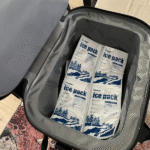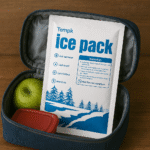Shipping Container Dry Ice Packs: Cómo garantizar un envío seguro y eficiente
Shipping container dry ice packs are crucial for maintaining temperature-sensitive goods at optimal conditions during transport. Si está enviando productos farmacéuticos, alimentos perecederos, or high-value chemicals, dry ice provides the necessary cooling power to preserve product integrity. This article explores the advantages of dry ice in shipping, its mechanism in temperature regulation, safety best practices, and how to ensure the most efficient and compliant shipping processes.

-
What are the advantages of using dry ice packs in shipping containers?
-
How do dry ice packs maintain temperature during transportation?
-
What are the best practices for using dry ice in container shipping?
-
How to ensure compliance with safety regulations when shipping with dry ice?
What Are the Advantages of Using Dry Ice Packs in Shipping Containers?
Dry ice packs are a favored solution in shipping containers because of their unique properties that provide consistent and efficient cooling during long-distance shipments. By sublimating directly into gas, dry ice eliminates the risk of water damage that other coolants might cause. Below are the key advantages that make dry ice an optimal choice for cold chain logistics:
Ventajas clave:
-
Enfriamiento duradero: Dry ice maintains a consistently low temperature over an extended period, which is ideal for shipments that need to stay cold for multiple days.
-
Lightweight and Efficient: Unlike conventional ice, dry ice occupies less space, which translates into reduced shipping weight and cost.
-
Sin residuos de agua: As dry ice sublimates directly to gas, it doesn’t leave behind any water, preventing potential damage to the products and packaging.
| Ventaja | Descripción | Practical Implications |
|---|---|---|
| Enfriamiento duradero | Maintains low temperatures for extended periods | Ideal for long shipping durations |
| Ligero & Eficiente | Compact and reduces shipping weight | Helps reduce transport costs |
| Sin residuos de agua | Sublimate al gas, leaving no moisture | Keeps products and packaging clean |
User Practical Tips and Recommendations
-
Para productos farmacéuticos: Dry ice is essential to maintain the efficacy of temperature-sensitive medications and vaccines during global shipments.
-
For Perishable Foods: Items like fresh seafood, carnes, and other perishables that require consistent cold temperatures benefit greatly from dry ice use.
-
For Chemicals: Certain chemicals, especially in research and biotech, need precise temperature regulation. Dry ice ensures these products remain stable during transport.
How Do Dry Ice Packs Maintain Temperature During Transportation?
Dry ice packs function by sublimating directly into CO₂ gas, creating a cooling effect inside shipping containers. The cooling process is essential for preserving sensitive goods that require sub-zero temperatures. Here’s how dry ice works in shipping:
Temperature Control Mechanism:
-
Direct Sublimation: A medida que el hielo seco se sublima en gas, enfría el aire circundante, which maintains the low temperatures inside the container.
-
Embalaje aislado: Properly insulated containers ensure that the dry ice doesn’t sublimate too quickly, extending the cooling duration.
-
Customized Dry Ice Quantities: The amount of dry ice used depends on the size of the shipment and the temperature requirements of the products.
| Shipping Container Setup | Key Feature | Eficacia |
|---|---|---|
| Aislamiento adecuado | Keeps dry ice from sublimating too quickly | Maximizes the cooling duration |
| Customized Dry Ice Amount | Adjusted based on shipment size | Ensures adequate cooling for products |
| Ventilación | Allows CO₂ gas to escape safely | Prevents dangerous pressure buildup |
Best Practices for Using Dry Ice in Container Shipping
Ensuring that dry ice packs work efficiently is crucial to meeting the temperature requirements of your shipment. Below are some best practices for using dry ice in shipping containers:
-
Correct Dry Ice Amount: Use approximately 1 a 2 pounds of dry ice per 10–15 pounds of product for every 24-hour period.
-
Effective Insulation: Proper insulation of the shipping container is vital for slowing the sublimation rate of dry ice, Asegurar que dure más.
-
Asegurar la ventilación: Proper ventilation is necessary to allow CO₂ gas to escape safely. Without adequate ventilation, the CO₂ can build up, potentially leading to hazardous conditions.
Safety Considerations When Using Dry Ice in Shipping Containers
Handling dry ice is not without its risks. As CO₂ sublimates into gas, it can cause asphyxiation or create pressure buildup inside the shipping container. Below are essential safety practices to mitigate these risks:
Safety Tips for Dry Ice Handling:
-
Usar equipo de protección: Use siempre guantes aislados, gafas de protección, and long sleeves when handling dry ice to avoid frostbite and burns.
-
Asegurar la ventilación adecuada: Shipping containers must allow for CO₂ gas to escape. Poor ventilation can lead to dangerous pressure buildup.
-
Capacitación: Anyone involved in handling dry ice should be adequately trained on its risks and proper handling procedures to ensure safety throughout the shipping process.
2025 Trends in Shipping Container Dry Ice Packs
As the cold chain logistics industry continues to evolve, so too does the use of dry ice in shipping containers. Here are the latest trends and developments shaping this space in 2025:
Descripción general de la tendencia:
-
Sostenibilidad: There is a growing emphasis on sourcing eco-friendly dry ice and utilizing sustainable packaging materials, driven by consumer and regulatory pressure.
-
Cumplimiento normativo: The shipping industry is adapting to new regulations focused on improving transparency and safety in the transport of pharmaceuticals, alimento, y suministros médicos.
-
Automatización en Logística: AI and IoT are becoming more prevalent in logistics solutions, improving the accuracy and efficiency of dry ice shipments while minimizing environmental impacts.
Últimos desarrollos de un vistazo:
-
Sostenibilidad: Emphasis on renewable energy-driven dry ice production and eco-friendly materials for packaging.
-
AI-Driven Optimization: Artificial intelligence is helping businesses optimize dry ice shipments, enhancing route planning and minimizing carbon footprints.
-
Regulatory Updates: New IATA and DOT regulations focusing on sustainability and updated packaging and labeling requirements.
Common Questions About Shipping Container Dry Ice Packs
Q1: ¿Cuánto tiempo puede durar el hielo seco en un contenedor de envío??
A1: El hielo seco puede durar hasta 72 horas, depending on the type of container and insulation used. Para envíos más largos, more dry ice may be required.
Q2: Is it safe to use dry ice in shipping containers for food?
A2: Sí, El hielo seco se usa comúnmente para enviar alimentos. It is essential to ensure proper sealing and insulation to maintain freshness.
Conclusión y recomendaciones
En resumen, shipping container dry ice packs are a reliable and efficient way to ensure your temperature-sensitive goods remain within the required temperature range during transit. By using the right amount of dry ice, employing effective insulation, and following best practices for safety, you can ensure the integrity of your shipments.
Siguientes pasos: If you’re planning to ship temperature-sensitive goods, consider consulting a logistics expert to optimize your dry ice usage and ensure compliance with all safety regulations.
Acerca de Tempk
Y tempk, we specialize in cold chain logistics solutions, including dry ice packs for shipping containers. Our products are designed to maintain your goods in optimal condition during transport, offering reliable and sustainable solutions for businesses in industries such as pharmaceuticals, alimento, y biotecnología.
Llamado a la acción: Contact us today to learn how we can assist you in optimizing your shipping processes with our dry ice solutions.























